Build it yourself preparedness farms?
Public domain Farm and industry plans.
Wednesday, April 27, 2011
Friday, April 22, 2011
Tuesday, April 19, 2011
Capillary action self-watering gardening
Two Buckets on a Mission
Is it possible two cheap plastic buckets can help reduce global malnutrition?
Sounds crazy, but there's some amazing technology that can be created by combining two cheap 5-gallon buckets along with some other low cost or free materials. The result is a low cost foolproof system of growing food.
Benefits of the 2-bucket system:
1) 50% to 80% reduction in water usage.
2) 100% reduction in weeds...never pull a weed or use herbicides.
3) Once planted, very little attention is required.
4) Foolproof: People with very little training (like us!) can reap bountiful harvests.
5) All you need are a few square meters of space...even rooftops, industrial wastelands, etc
Two Brothers on a Mission
Our vision: Turning the rooftops and abandoned industrial wastelands of developing countries into mini-farms filled with green growing vegetables. The goal of this website is to share with the world the simple steps required to build the 2-bucket system.
Heads up for Canadian Dirtbags and All you need is mud for the idea - make gardening easy(er).
Wednesday, April 13, 2011
Bug Out Bag essentials - the backpack cooking stove
More reviews and demonstrations of backpacking stoves and types.
The Wood burning backpacking stoves.
Vargo Hexagon Wood Stove, similar to the steel folding stove, this type of stove uses small pieces of scrap wood. Easy to carry and fuel is available scrap, same drawback as wood - smoke.
The alcohol backpacking stoves.
Require a fuel to be packed, easy to light, fast, hot, and clean burning - no smoke.
The Wood burning backpacking stoves.
Vargo Hexagon Wood Stove, similar to the steel folding stove, this type of stove uses small pieces of scrap wood. Easy to carry and fuel is available scrap, same drawback as wood - smoke.
The alcohol backpacking stoves.
Require a fuel to be packed, easy to light, fast, hot, and clean burning - no smoke.
Wednesday, April 6, 2011
Tuesday, April 5, 2011
Nutrition, yes the sugar is different!
Listen to a real scientest explain solid research about glucose, sucrose and fructose.
Robert H. Lustig, MD, UCSF Professor of Pediatrics in the Division of Endocrinology, explores the damage caused by sugary foods. He argues that fructose (too much) and fiber (not enough) appear to be cornerstones of the obesity epidemic through their effects on insulin. Series: UCSF Mini Medical School for the Public
Camping is learning
I can taste the smoke and camp coffee now...
Water filter - trust me you do not want to get sick, a water filter is a must.
Cooking - This is an inexpensive hobo stove that saves fuel (lots more effective than an open fire) and is easy to make, I made one just from the photos and the video in less than 1 hour.
The charcoal chimney starter, simply cut a hole into the side to drop fuel into and punch a few holes at the top if it does not have them - instant camp stove.
Backpacks - this was covered here.
Thinking about it how about some ideas on camping and how that can help us...
What about all the new tent cities? Are you ready?
Camping, the most miserable is the most valuable, nothing like spending three days under a tarp with non stop rain, hail, and light snow in the spring up 8000 plus feet to make you understand the importance of warm and dry sleeping preparations.
How to get started?
Tent or tarp - the less the better, I am a big fan of the hammock tent, comfy and keeps you dry and off the ground. Get the smallest you think you can suffer with, that is the simplest to set up - the center pole teepee tents are great for multiple people (they are heavy) or a bivy tent. Also think about a bivy sack or bug net bag and tarp, once you give up the tent and go tarp or hammock you will never go back... I just converted to hammock, but I have been a tarp guy for years as my "go to" - I have a bivy tent but I don't use it as much as the the tarp.

You can make a tent or tarp or hammock tent! you do not have to buy one - in fact the best bivy tent I ever used was made by a friends wife as per her design for "needs" - smart gal.
Sleeping bag - the warmer the better - get a bag rated for 10 deg or lower than the COLDEST temp you think you will ever see! I will not get into the synthetic vs. down argument you need to research that yourself, it comes down to a few things, price, warmth, moisture, weight, and bulk - if you do not have a bag now - get one! Coleman mummy bags with synthetic fill it will be bulky and heavy but trust me you do not want to be wet and cold to try and sleep!
Sleeping bag liner - make one or buy a fleece bag liner (wal-mart, for less than 20) keeps the crud off the bag and helps ventilate the moisture out of the bag.
How to get started?
Tent or tarp - the less the better, I am a big fan of the hammock tent, comfy and keeps you dry and off the ground. Get the smallest you think you can suffer with, that is the simplest to set up - the center pole teepee tents are great for multiple people (they are heavy) or a bivy tent. Also think about a bivy sack or bug net bag and tarp, once you give up the tent and go tarp or hammock you will never go back... I just converted to hammock, but I have been a tarp guy for years as my "go to" - I have a bivy tent but I don't use it as much as the the tarp.

You can make a tent or tarp or hammock tent! you do not have to buy one - in fact the best bivy tent I ever used was made by a friends wife as per her design for "needs" - smart gal.
Sleeping bag - the warmer the better - get a bag rated for 10 deg or lower than the COLDEST temp you think you will ever see! I will not get into the synthetic vs. down argument you need to research that yourself, it comes down to a few things, price, warmth, moisture, weight, and bulk - if you do not have a bag now - get one! Coleman mummy bags with synthetic fill it will be bulky and heavy but trust me you do not want to be wet and cold to try and sleep!
Sleeping bag liner - make one or buy a fleece bag liner (wal-mart, for less than 20) keeps the crud off the bag and helps ventilate the moisture out of the bag.
Water filter - trust me you do not want to get sick, a water filter is a must.
Cooking - This is an inexpensive hobo stove that saves fuel (lots more effective than an open fire) and is easy to make, I made one just from the photos and the video in less than 1 hour.
The charcoal chimney starter, simply cut a hole into the side to drop fuel into and punch a few holes at the top if it does not have them - instant camp stove.
Backpacks - this was covered here.
Prepping, start small and simple

Beware the "mall ninja” approach& to your preparations. Don’t overwhelm yourself with too much of the yuppie survivalist big-money types that fill some of the blogs.
I am a confirmed gun wonk of the first order, and the very nature of the "gun culture" can lead anyone into excessiveness. Yes buy ammo and a good selection of good firearms, but the most needed supplies will not be very "sexy”.
Evaluate your situation, at this point it looks as if we are going to have an economic collapse& and it will take some time and will be more obvious than we expect.
The time is here to stock "fill ins" such as canned goods, start with adding a few cans every grocery trip, I suggest items that complement your dry good storage, items of higher vitamin content that are not available in reasonably priced dry form.
Canned food info - storage life
A canned food storage rack
Canned foods suggestions:
Carrots
Sweet Potatoes
Pumpkin
Spinach
Tomatoes and paste
Peaches, pineapple, blueberries and other fruits
Meats (tuna, ham, and others)
Milk
Peppers and Salsa blends
Dried foods
Potato flakes
Milk
Rice
Beans
Eggs (not always available at the grocery store, try mail order)
Pasta (whole wheat)
Wheat (not always available at the grocery store, try local Health foods suppliers)
Adding small selections of items each trip will help add to the storage plan.
The French Connection in the history of the M1 Garand Rifle
The forgotten French developmental history of the All American M1 Garand rifle
- OR -
A funny thing happened in France on the way to develop a Main Battle Rifle.

The United States Rifle, Caliber .30, M1 aka - "M1 Garand"
The United States Rifle, Caliber .30, M1 designed by John C. Garand often with the same reverence of a god or the Titan Prometheus the giver of fire. Just as Zeus's warning to Prometheus that every gift brings a penalty - that man is happy as long as he does not gain the knowledge that can change his world.
Mr. Garand's rifle would certainly play a part in the changes in the world. How could the M1 be any less with production in the multiple millions, the M1 rifle had the highest front line infantry distribution of any issued semi-automatic rifle of the World War II.
All American military firearms collectors have all heard the story of the later development of of the M1 rifle by John Garand, his tenacity in wanting the "primer actuated" action and his quick development of the .30 caliber rifle over the earlier .276 experiments. Our question is where did all this come from, why the .276 and where do we trace the ideas and origins of the M1?
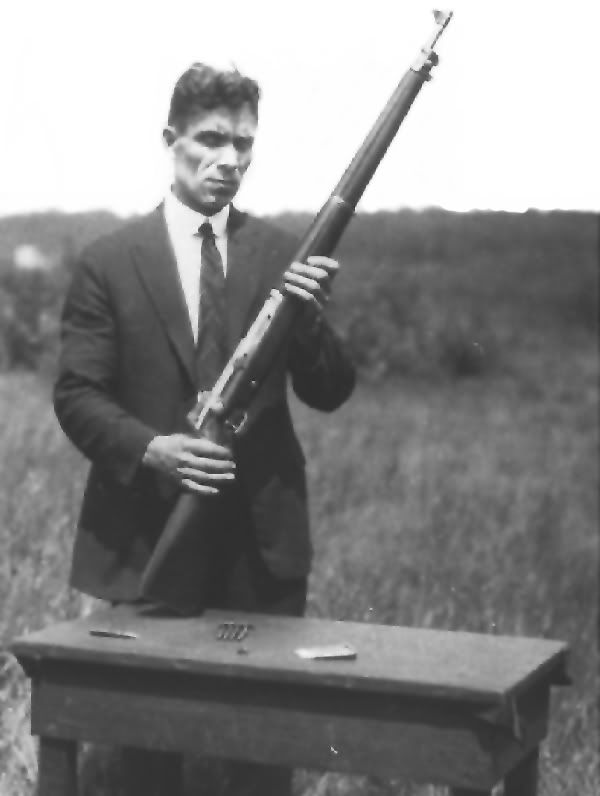
Mr. Garand with one of his prototypes (note the cocking handle and op rod).
While I was researching the development of the French MAS 49-56 rifle I came across a comment, "...the trigger group from the MAS is so similar to the M1 it must have been a development from the M1."
Because the French MAS auto-loading rifles dates of development are far too early for this to be the case I started to find connections and they start in France.

The RSC Mle.1917 French auto-loading rifle.
Where did it start? The connection starts with the then new weapon, designed by Ribeyrolle, Sutter and Chauchat, a rifle that would become the Le fusil automatique de 8 mm RSC modele 1917 or RSC Mle. 1917.
Over 80 thousand rifles of RSC Mle. 1917 were produced for the French army in 1918. France arming it's soldiers in large numbers with a self-loading rifle was a forward thinking concept at the time. The production numbers of the RSC Mle.1917 show a clear intent of France to equip many of it's infantry with the rifle and attempt to change their battlefield tactical procedures.
But we need to back up a bit and talk about Mr. Garand and the connection to the Le fusil automatique de 8 mm RSC modele 1917 or RSC Mle.1917 and Mle. 1918.
Mr. Garand was born Jean Cantius Garand born in Quebec part of a French speaking family, later Mr. Garand was to list his name in the Anglo form John. There are many articles and books focused on his famous rifle that describe some of Mr. Garand's poor childhood and his early entry into machine design. Mr. Garand's talents for mechanical devices and unusual ideas fill more than a few pages of historical reviews. I find Mr. Garand's story in many ways similar to some of the aspects of Mr. Kalashnikov and his talents. Both men seem to be tireless tinkering mechanical obsessives with a few eccentricities (a sign of creativity).
What is almost always missing is the work Mr. Garand did with Springfield Arsenal where he was involved with attempts to adapt the RSC Mle. 1918 design to the 30-06 cartridge. With this early Springfield Arsenal we now we have our direct connection from early concept rifle to the development of the United States Rifle, Caliber .30/M1.
So now we can clearly review how French rifle design had such a large impact on military rifles. The question is why is this rifle so forgotten when it clearly is so important to military self-loading rifle history?
My conclusion was that the "all American rifle" indeed had a French grandfather and a French Canadian father. Who would have guessed that M1 would have been that French in lineage. The closer you look the more connections you can make in the relationship from one rifle to the other. I would even hazard a guess that the .276 was a reaction to the problems with higher pressure cartridges and auto-loading rifles like the RSC Mle.1917, metallurgy would of course later improve negating that concern.
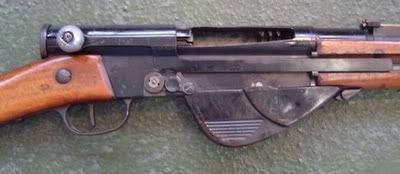
RSC Mle.1917 with bolt and op rod in the reward position.
It is like the first time you find the connection from sewing machines and gun manufacturing and strangely history becomes interesting, unlike your old boring classes in school.
Lets start with a simple review of the two rifles with photographs.

The RSC Mle. 1917 trigger group (a progression from a Browning design, used to this day in many firearms).
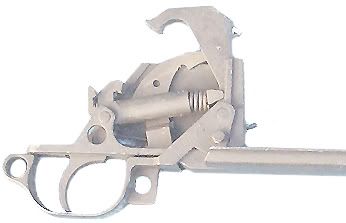
The M1 Garand trigger group (note the improvements).
As you can see from the photos there are clear indications that the US M1 and even later rifles have trigger groups that show a mechanical lineage to this rifle. The spring and detents of the RSC Mle. 1917 look a lot like same parts in the much later M16 as the mechanism of the RSC Mle. 1917 is quite simple. I thought it was noteworthy how you can see the development and the source from the RSC Mle. 1917 to the M1 Garand. For any of you interested the above also links to the Browning Auto shotgun the source for many derivative designs in trigger/hammer design.
The operating rod is so obvious that I am surprised this has not been noted more often (if at all).
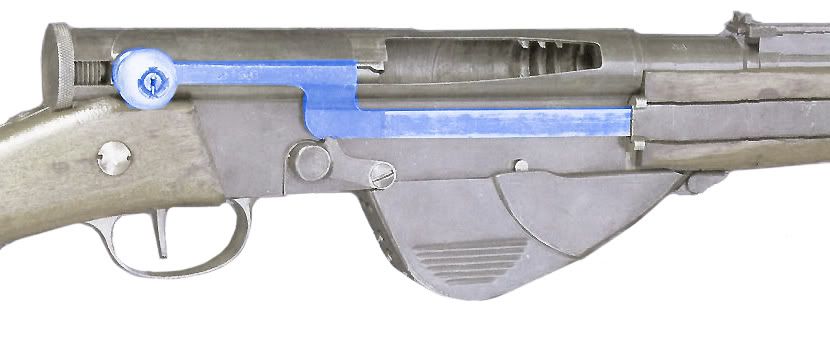
RSC Mle.1917 side view with operating rod highlighted.

RSC Mle.1917 operating rod disassembled from the rifle.
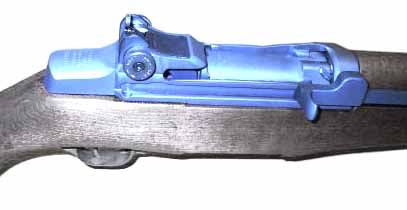
M1 Garand side view with operating rod highlighted.
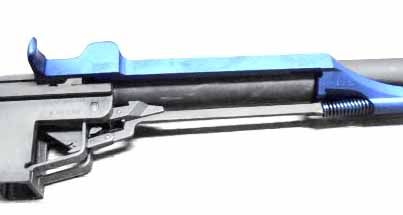
M1 Garand operating rod on a partly disassembled rifle, highlighted in blue.
The "en block" clip always catches my attention.

RSC Mle.1917 worm's eye side view of the "en block" clip highlighted, note that this rifle was designed to have the clip inserted from the bottom after the casing was rotated forward.
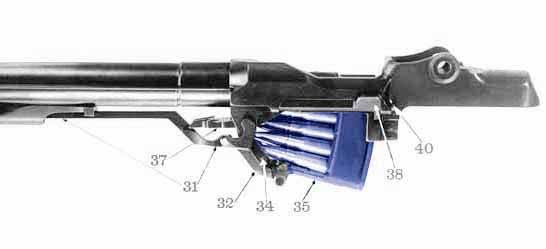
M1 Garand .276 prototype with side view of the "en block" clip highlighted in blue.
The bolt group - ahead of it's time?
Some views of the bolt group from both rifles you can clearly see the rotating mechanism and how the RSC Mle.1917 connects to it's flat op rod and how the M1 Garand has a "floating" connection slide built into the op rod.
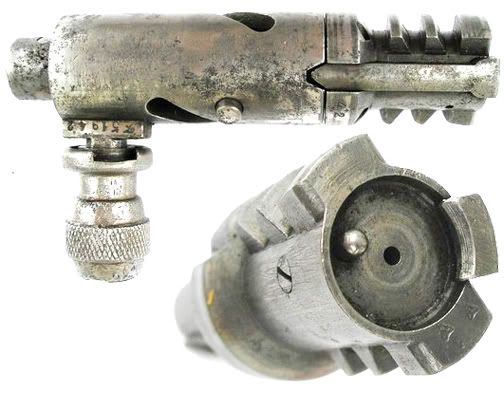
RSC Mle.1917 bolt and bolt face.
Note how the cocking handle knob threads onto a protruding shaft to connect to the op rod. Note the multiple lugs on the bolt, this complexity is one of the binding areas for contamination and fouling.
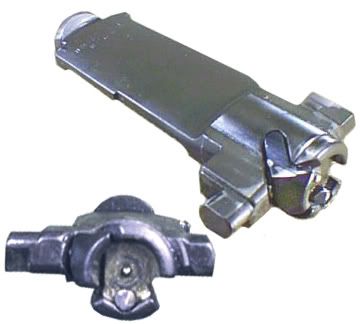
M1 rifle's bolt and bolt face.
Note the improvements over similarities from the M1 bolt and it's predecessor Garand’s improvements are many his improved op-rod and bolt are noteworthy.
Patent drawings comparing the two rifle designs.
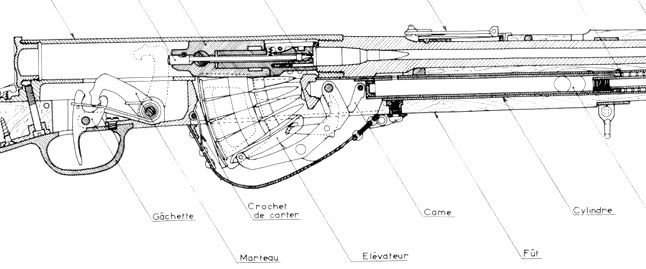
RSC Mle.1917 rifle drawing, note the relationship of the working parts.
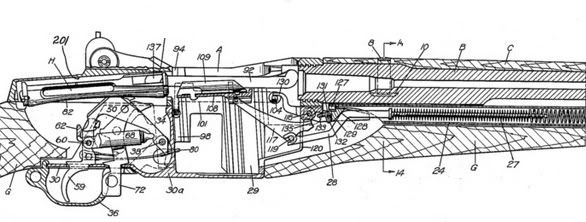
Mr. Garand's .276 prototype drawings.
While in no way a direct copy, clearly Garand’s review of the French rifle earlier in his life left a lasting impression and this system eventually developed into the Garand designed rifle. Some criticism could be leveled because there are so many other rifle designs that also did lend features, but Garand’s direct connection to the original French rifle via his employer and direct study is unmistakable.
There is no shame in admitting that “America’s Rifle” had French origins, that is unless bumper sticker patriotism and beer clouded pride is more important.
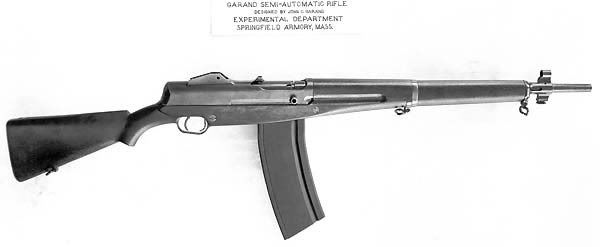
As an historical item, Mr. Garand's Springfield Arsenal magazine fed prototype rifle for consideration.
Information gathered from:
Small Arms of the World: A Basic Manual of Small Arms (12th revised edition)
By - Edward Clinton Ezell
Proud Promise
French Autoloading Rifles, 1989-1979
By - Jean Huon
The FN-49, The last elegant old-world military rifle
By - Wayne Johnson
Les fusils semi-automatiques:
Le fusil automatique de 8 mm RSC modèle 1917
Le fusil FN FAL expliqué
Par - G. Henrotin
Armes à feu de l'Armée française 1860 à 1940
Par - Jean Martin chez Crepin Leblond
L'Armement De L'Infanterie Francaise 1918-1940
éditeur - Argout - Gazette des armes
la grande aventure des fusils réglementaires français 1866-1936
éditeur - Argout - Gazette des armes
La Notice Sur Le Fusil à Répétition De 7,5 Mm. Modèle 1936
éditeur - Charles Lavauzelle & Cie
More information has popped up from the original article above.
RSC 1917 et Garand
Long term food storage information, Wendy Dewitt of LDS
One of nine videos from a lovely woman who is part of the LDS church (Mormon), lean on the LDS - EVEN IF YOU ARE NOT LDS - I am not, and I use them for information on this issue. I don't have to agree with the spiritualism but the wisdom of the preparation is useful. The LDS has huge amounts of information on food storage.
Food storage, go to experience - LDS members.
Food Storage Seminar, "Questions and Answers"
The 72 hour kit (Bug-out-bag)
From San Fran the 72hours.org site.
72hours.org
The Best Preparedness magazine out there. (Just ignore Mas, the token collectivist)
www.backwoodshome.com
Disaster preparation!
More on this later.
72hours.org
The Best Preparedness magazine out there. (Just ignore Mas, the token collectivist)
www.backwoodshome.com
Disaster preparation!
Tips for choosing a backpack
Start with questions for yourself.
Do you need a backpack?
There are other options, not the least of them is the "rickshaw" or "game cart". You can carry more weight with a rickshaw cart, but the wheels can limit you in the locations you can go, a backpack will go where you go, but you will not be able to carry as much weight.
How much "stuff" will I need to pack?
How many pockets and how much do you need to carry? If alone, you will carry more, but take a hint and drop as much as you can, carry only what you need - study the ultra-light backpackers and the "live on the land" type of trekkers for tips and tricks.
Think about what you need, and consider outside strapping and internal size that may be required.
There is a general "rule of thumb" you will see with pack manufacturers but I find that if you do it correctly you can go the next size under.
A single "day hike" or "overnighter" to about one week (adding food from plants or fishing/hunting) or in places where you need tools or equipment would require packs in the range of 1,800-2,500 cubic inch (30-40 liters) internal space. Adding outside strapping for odd tools this need could be less than half for short trips...
A pack in hike where you will be spending more that two days you may want to consider a pack in the size of 3,000-5,000 cubic inch (50-80 liters), this is a relatively large pack, personally I have never had a pack larger than 4,800 cubic inches and you can keep up with three weeks of food (if you are adding to that with local plants and or fishing/hunting).
Packs that are more than 5,000 cubic inch (80 liters and more) capacity would be almost "expedition" level packs, or packs where a large amount of tools, shelter, or clothing would be required.
What type of backpack?
Any pack (regardless of type) that is adjusted incorrectly will cause you pain and be difficult to take for long periods of traveling.
All packs are designed to place a majority of the weight on your hip belt! Both internal and external frame packs should have tight fitting, well padded, well designed hip belts! DO NOT depend on the shoulder straps to carry the weight for long periods of time.
There are two basic types of advanced backpacks the internal frame type and the external frame type.
Internal frame backpacks.
Internal frame backpacks are currently the most popular, take care to fit your pack correctly as an internal frame MUST BE adjusted correctly for you, and often you will need to try several packs out to find one that "fits". It is harder to find a well fitting internal frame pack than you would think - go to a store to check them out, be aware that many who will "help you" are one or two season packers, they may not take into account your needs for all seasons. "Four season" equipment is designed for Winter PLUS the other seasons, all other "season" levels are for less demanding camping seasons. Remember camping is considered a recreational activity in the US, take this into consideration when you get advice from well traveled backpackers.
The internal frame packs are typically lower slung, narrow, and will balance well for walking, even when climbing hills and rocks or steep trails. You will be likely to travel along narrow trails quicker and the pack will allow you to even stoop, crawl, or drag yourself in a low crawl without removing the pack (if the space is large enough for you and the pack, it is closer to your body but it does not disappear).
Drawbacks to internal frame packs are related to its lack of a frame, it sits closer to your body and will cause you to perspire, this can be a killer in the winter if you wet your clothing, I made a trip many years ago in winter and got wet, that first night was the most miserable I have ever experienced, I could not get warm and I did not have "night dress" or a bag liner so I could strip down and get the wet clothes off... That was also the last internal frame pack I ever used in cold weather.
Internal frame packs will also not carry as much weight as an external frame pack will, you also must place the heavy items to the bottom of the pack to keep the balance internal frame packs are capable of providing.
Because they are popular, there are many internal frame packs to choose from, the models used by the military are heaver, poorly designed, and unless you happen to be "standard size" poor fitting, for the money there are many choices available that would be a better fit and design (they just come in crap colors - this is an easy fix with a waterproof pack cover).
External frame backpacks.
External frame backpacks over the years have lost their popularity, with the exception of winter trekkers and hunters.
It is easier to find a well fitting external frame pack often getting a great match without having to go to a store to check twenty pack brands and sizes. External frame backpacks just as internal frame are not specifically rated by season, but there are reasons I would place the external frame pack style as a "Four season" pack. Winter has its own sets of demands and ventilation away from winter clothing is the number one reason for an external frame pack, with the ability to carry much more weight in a more "hiker mule" fashion.
The external frame packs typically ride much higher on the back, are wider. External frame packs will balance high and are great for heavy weights on more even ground, they are not particularly well suited for climbing hills and rocks or steep trails. You will be forced to consider travel along narrow trails with detail and forethought, because a high riding heavy pack will require you to remove the pack for small spaces and may even have to drag a pack behind you if the space is low enough.
Drawbacks and benefits to external frame packs center on the rigid frame. The rigid frame will help control perspiration by keeping the pack off your clothing and body except for the main contact points. In winter a rigid frame pack is almost a requirement. The pack is removable from the frame and the frame can be used to pack our large items - one reason the external frame packs are so popular with hunters.
External frame packs will easily carry double the weight an internal frame pack is capable of carrying and will carry that weight more comfortably for the user. Be careful not to place too many heavy items at the top of the pack, an make your self any more top heavy and off balance than is necessary..
Because there are fewer models of external frame packs available, there is a huge price varriance, strangely some of the best designs for external frame packs are the LEAST EXPENSIVE! The models used by the military are heavy, pathetically ill designed, and poor fitting. Just as with internal frame packs there are many superior packs for the money than are available as military surplus.
I suggest some of the least expensive packs as starters, as strange as it sounds I have come full circle back to the inexpensive external frame packs as my main use pack now.
I use the Outdoor Products "Saturn" external frame style pack, as the frame is flexible and I broke my last Cabela "Extreme Alaskan Outfitter" when I fell back on it against a rock wall - that is the last expensive pack I get, next trip I used my son’s Outdoor Products "Saturn" and decided I would get one for myself - a bit heavy (5.5 lbs empty) but flexible and I enjoy it far more than any other external frame pack I have ever used.
There is no need to pitch out five to seven hundred bucks for a pack!
Try this link for Outdoor products inexpensive but good and useable packs, from one of my favorite camping suppliers on the web - Campmor.
Campmor Outdoor Supply
Do you need a backpack?
There are other options, not the least of them is the "rickshaw" or "game cart". You can carry more weight with a rickshaw cart, but the wheels can limit you in the locations you can go, a backpack will go where you go, but you will not be able to carry as much weight.
How much "stuff" will I need to pack?
How many pockets and how much do you need to carry? If alone, you will carry more, but take a hint and drop as much as you can, carry only what you need - study the ultra-light backpackers and the "live on the land" type of trekkers for tips and tricks.
Think about what you need, and consider outside strapping and internal size that may be required.
There is a general "rule of thumb" you will see with pack manufacturers but I find that if you do it correctly you can go the next size under.
A single "day hike" or "overnighter" to about one week (adding food from plants or fishing/hunting) or in places where you need tools or equipment would require packs in the range of 1,800-2,500 cubic inch (30-40 liters) internal space. Adding outside strapping for odd tools this need could be less than half for short trips...
A pack in hike where you will be spending more that two days you may want to consider a pack in the size of 3,000-5,000 cubic inch (50-80 liters), this is a relatively large pack, personally I have never had a pack larger than 4,800 cubic inches and you can keep up with three weeks of food (if you are adding to that with local plants and or fishing/hunting).
Packs that are more than 5,000 cubic inch (80 liters and more) capacity would be almost "expedition" level packs, or packs where a large amount of tools, shelter, or clothing would be required.
What type of backpack?
Any pack (regardless of type) that is adjusted incorrectly will cause you pain and be difficult to take for long periods of traveling.
All packs are designed to place a majority of the weight on your hip belt! Both internal and external frame packs should have tight fitting, well padded, well designed hip belts! DO NOT depend on the shoulder straps to carry the weight for long periods of time.
There are two basic types of advanced backpacks the internal frame type and the external frame type.
Internal frame backpacks.
Internal frame backpacks are currently the most popular, take care to fit your pack correctly as an internal frame MUST BE adjusted correctly for you, and often you will need to try several packs out to find one that "fits". It is harder to find a well fitting internal frame pack than you would think - go to a store to check them out, be aware that many who will "help you" are one or two season packers, they may not take into account your needs for all seasons. "Four season" equipment is designed for Winter PLUS the other seasons, all other "season" levels are for less demanding camping seasons. Remember camping is considered a recreational activity in the US, take this into consideration when you get advice from well traveled backpackers.
The internal frame packs are typically lower slung, narrow, and will balance well for walking, even when climbing hills and rocks or steep trails. You will be likely to travel along narrow trails quicker and the pack will allow you to even stoop, crawl, or drag yourself in a low crawl without removing the pack (if the space is large enough for you and the pack, it is closer to your body but it does not disappear).
Drawbacks to internal frame packs are related to its lack of a frame, it sits closer to your body and will cause you to perspire, this can be a killer in the winter if you wet your clothing, I made a trip many years ago in winter and got wet, that first night was the most miserable I have ever experienced, I could not get warm and I did not have "night dress" or a bag liner so I could strip down and get the wet clothes off... That was also the last internal frame pack I ever used in cold weather.
Internal frame packs will also not carry as much weight as an external frame pack will, you also must place the heavy items to the bottom of the pack to keep the balance internal frame packs are capable of providing.
Because they are popular, there are many internal frame packs to choose from, the models used by the military are heaver, poorly designed, and unless you happen to be "standard size" poor fitting, for the money there are many choices available that would be a better fit and design (they just come in crap colors - this is an easy fix with a waterproof pack cover).
External frame backpacks.
External frame backpacks over the years have lost their popularity, with the exception of winter trekkers and hunters.
It is easier to find a well fitting external frame pack often getting a great match without having to go to a store to check twenty pack brands and sizes. External frame backpacks just as internal frame are not specifically rated by season, but there are reasons I would place the external frame pack style as a "Four season" pack. Winter has its own sets of demands and ventilation away from winter clothing is the number one reason for an external frame pack, with the ability to carry much more weight in a more "hiker mule" fashion.
The external frame packs typically ride much higher on the back, are wider. External frame packs will balance high and are great for heavy weights on more even ground, they are not particularly well suited for climbing hills and rocks or steep trails. You will be forced to consider travel along narrow trails with detail and forethought, because a high riding heavy pack will require you to remove the pack for small spaces and may even have to drag a pack behind you if the space is low enough.
Drawbacks and benefits to external frame packs center on the rigid frame. The rigid frame will help control perspiration by keeping the pack off your clothing and body except for the main contact points. In winter a rigid frame pack is almost a requirement. The pack is removable from the frame and the frame can be used to pack our large items - one reason the external frame packs are so popular with hunters.
External frame packs will easily carry double the weight an internal frame pack is capable of carrying and will carry that weight more comfortably for the user. Be careful not to place too many heavy items at the top of the pack, an make your self any more top heavy and off balance than is necessary..
Because there are fewer models of external frame packs available, there is a huge price varriance, strangely some of the best designs for external frame packs are the LEAST EXPENSIVE! The models used by the military are heavy, pathetically ill designed, and poor fitting. Just as with internal frame packs there are many superior packs for the money than are available as military surplus.
I suggest some of the least expensive packs as starters, as strange as it sounds I have come full circle back to the inexpensive external frame packs as my main use pack now.
I use the Outdoor Products "Saturn" external frame style pack, as the frame is flexible and I broke my last Cabela "Extreme Alaskan Outfitter" when I fell back on it against a rock wall - that is the last expensive pack I get, next trip I used my son’s Outdoor Products "Saturn" and decided I would get one for myself - a bit heavy (5.5 lbs empty) but flexible and I enjoy it far more than any other external frame pack I have ever used.
There is no need to pitch out five to seven hundred bucks for a pack!
Try this link for Outdoor products inexpensive but good and useable packs, from one of my favorite camping suppliers on the web - Campmor.
Campmor Outdoor Supply
Analyzing accuracy in a rifle
Note the hidious new camouflage the army "developed" - pathetic and stands out like a sore toe, and to think they could have had the Multicam! (More on camo later)
A post from Total Survivalist Libertarian Rantfest made me think of this bit of info about rifles.
The posts were generally about the new Army Stoner weapons platform in 7.62x51 NATO (.308 win) the "AR-10" XM110 SASS model rifle.
While the Stoner platform is quite old (and outdated IMO) the M14 is even older (based on the M1), the Stoner designed system is easier to produce and "make accurate" with less effort than is needed with the M1/M14 Garand system. and has features that make in inherently more accurate, many that are shared by the common bolt action rifle (that of course can be more accurate than either rifle system.
Of course the largest problem with the direct impingement system is heat (from the ejection gasses) and contamination (gas produced and from outside the action - ie: dirt, sand) induced failure - as our military is intimately familiar with the Stoner design and trained on it's weaknesses this should not be a excessive problem (particularly in this role).
Accuracy in a rifle depends on several things (strictly the mechanical design and construction).
First think about accuracy without the shooter, (outside of mechanical problems the shooter is ALWAYS the point of fail as the most inconsistent part of the total).
What are the most accurate rifles in the world?
While the Stoner platform is quite old (and outdated IMO) the M14 is even older (based on the M1), the Stoner designed system is easier to produce and "make accurate" with less effort than is needed with the M1/M14 Garand system. and has features that make in inherently more accurate, many that are shared by the common bolt action rifle (that of course can be more accurate than either rifle system.
Of course the largest problem with the direct impingement system is heat (from the ejection gasses) and contamination (gas produced and from outside the action - ie: dirt, sand) induced failure - as our military is intimately familiar with the Stoner design and trained on it's weaknesses this should not be a excessive problem (particularly in this role).
Accuracy in a rifle depends on several things (strictly the mechanical design and construction).
First think about accuracy without the shooter, (outside of mechanical problems the shooter is ALWAYS the point of fail as the most inconsistent part of the total).
What are the most accurate rifles in the world?
The most accurate rifles are not sniper rifles, hunting rifles, or varmint rifles but the Benchrest rifles (Starting cost 3-4k and up, stock, action, barrel - scope extra). Benchrest rifles are designed to eliminate the shooter as much as possible (at least from his physical limitations, grip trigger pull etc.). There are two classes of rifle the Light category at 16.5 to 17 lbs and The heavies are rifles that often have stocks that are CNC produced of solid aluminum or laminated wood and the weight is unlimited, a typical Heavy would be 35 lbs. or heavier. Groups of ten shots within 8 inches at 1000 yards are top scoring! World record is under five inches, a five to six inch group is considered exceptional.
- Quality Materials
- Tight repetitive action movement
- Lack of conflicting or interfering forces
- Lack of vibration, or repetitive vibration dampening
- The straightness of parts alignment
- Consistent and tight locking
Why list all of that - because the Stoner platform is inherently more accurate than the M14. It is more accurate because of design such as the bolt that slides straight back, the locking head of the bolt only turns slightly to lock and the barrel can have all but the gas return tube detached and away from the barrel.
All larger capacity rounds will gain accuracy with a shorter "squat" metallic case for more even burn of powder - the main reason .308 is more accurate and consistent than the 30-06.
That is the mechanical part - true accuracy comes from the ability of the shooter to judge external conditions (grade, wind, distance, humidity, temp., and elevation/air pressure).
The Stoner platform mechanical flaws rest in the tight fitting of the bolt inside the action, the fact that forward movement and contact with the bolt head and the cartridge to be fed into the breech causes the bolt head to turn slightly and cause the lug on the side rear of the head to dig into the side of the action (no spring to resist such as the HK 416) with the addition of even modest fouling or contamination this can cause several types of failure.
More Rocket Stoves!
The high-efficiency Rocket stove wood burning stove for use in Central America and other third-world countries the expansion of Appropriate Technology and Disaster preparations advancements.
The BOB/GOOD tarp-tent and hammock DIY project
After years of searching or a backpacking tent that worked well, the hammock tent is comfortable, easy to make, lightweight, great for foul weather, and can even be used on the ground as a regular tent if needed. Bug and snake proof and more comfortable than the ground, works well in cold weather also when set up correctly with an under-sling bag.
See project here...
Down and dirty, get ready now!
The small quick cabin with Stromberg’s Starplate
The quick cabin - most likely the most economical shelter building kit available - with simple pipe or 2x4 or 2x6 lumber you can build a small cabin that will sleep about 6 people, close quarters but with insulation and a small inexpensive wood stove.
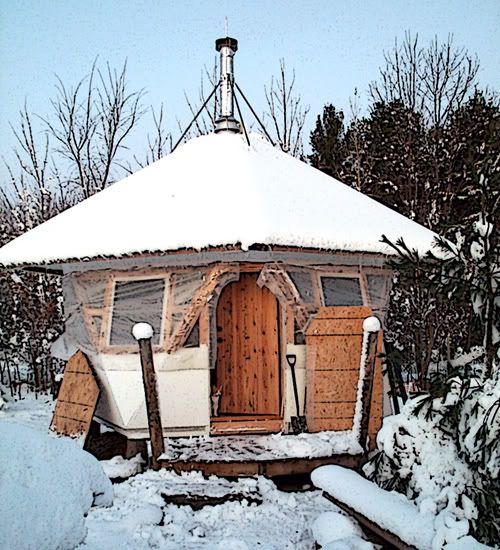
The system is quite easy to use and several cabins can be built for the cost of a single pre-built.
The Eco-Cabin blog
Lodge-Tech has even turned it into a geodesic/yurt kit.
Check out the wooded seclusion yurt.
Stromberg’s Starplate systems

The system is quite easy to use and several cabins can be built for the cost of a single pre-built.
The Eco-Cabin blog
Lodge-Tech has even turned it into a geodesic/yurt kit.
Check out the wooded seclusion yurt.
Stromberg’s Starplate systems
Swaging jacketed bullets a new skill for TEOTWAWKI
I make by swaging jacketed rifle bullets of several types and caliber and even more pistol styles and calibers using Corbin equipment (had other more expensive equipment available in the 70s to the 90s but have chosen Corbin for the superior quality and higher quality product produced). And just to be honest, I did use swaging for rifle as a business (class 6) and sold custom special product nation wide in the past but sold the business - I guess that makes me a former "professional".
I am a reloader from 1978 or so and swager from 1982. I guess cost to me was always relative, while in the business of making bullets for demanding customers the best tools were necessary... While I did sell most of my equipment I did cherry pick a good selectionof manual tools and a few caliber choices to continue as a hobby.
I can tell you without any reservations that it is much better as a hobby rather than a profession. I also note that reloading in general and casting (I still do some casting, but prefer jacketed bullets) and particularly swaging are rare, not particularly for saving money (yet that seems to be an issue again now) and appeals to a narrow personality type (my wife would call it a disorder). I am about the youngest swaging loader I know of (not 50 for some time yet).
As luck would have it swaging is not that hard to get into if you plan to swage small caliber or pistol bullets (lead or jacketed) as there are “reloading press” swage dies. Although I use a large array of expensive dies I have lots of respect for the CH/4D effort to keep home swaging dies within reason (cost) along with the limited selection of reloading press dies available from Corbin or RCE/Walnut Hill.
Honestly I loved reloading so much that I accidentally got into swaging when I was taking a hunter education course. The older gentleman who was teaching the class was an old buddy of my grandfathers and he had an old swage set from Ted Smith that would do jacketed and 3/4 .357...
I was hooked and then saved up to get my first M style press (I still have it) and started with .224 and then .308 then 9mm, .357 and on.
Swaging like reloading is for the most part not for saving money but rather doing something others cannot produce. A nice thing about making .224 bullets (what the .223/5.56 uses) with old .22 shells is the thin jacket great for varmint shooting, the .22 LR makes a particullarly thin jacket and the FPS that thin jacket can take is almost maxed out with the .223/5.56. For shooting pests and non fur gathering coyote shooting you can't beat a frangable .223 with a thin jacket .22 lr conversion, the bullets are often ugly and great care must be taken not to fold the jacket over (heat-treating helps) - so to make the point again, money savings is killed by the higher labor/time nessassary.
Looking over the Corbin website I was checkig the .22 lr conversion dies (work with a reloading press) to iron out the rim on a .22lr is $130 then you could add the reloading die type set to seat the core and form the point that set is $348.00. That is a 2-die set for .224 cal and makes an 6-S ogive. 6s is a standard ogive, a middle of the road point curve with 3-5 good for heavy hunting bullets with a more rounded nose and 8 plus reserved for target/long range shooting. When I got my first set of conversion dies I jumped full in and got dies and the special press along with the reloading press dies for ironing out the .22 lr rims... the entire set cost less than the above together...





My first MM style press was the "gold" series press (the shortest run ever made) cast from an industrial non spark bronze (and gave it the gold color - now with a nice patina green/brown/gold). If you wanted to cut lead wire or cast cores to weight and seat the core or use "sand shot" to make frangable cores the reloading dies work well as long as you have a good strong press like the Lee Classic Cast Press, RCBS Rock Chucker Supreme (both minumum), or the CH4D Heavy Duty Champion Press. I would not recomend any speciality press or turret press for this operation.
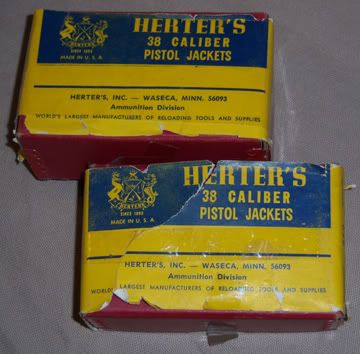
Just to be fair CH4D also makes dies for swaging, but most are made for jacketed pistol bullets, the dies are based on some of the older Herters reloading die thread type of dies. That CH4D press is also a great monster reloading press! For swaging I prefer the Corbin or Walnut hill type press (can double as a super heavy reloading press). The CH/4D dies also require a mallet or a drag-down frame that pushes out the bullet when you return the handle on the press.

The Corbin press with the CH/4D dies and the ejector frame device attached (the threaded posts)
When I ran the business I had a knack for creative bullet design and sold to a specific group of markets - Benchrest, Varmint shooters, and Special demands... All three markets, at least for me represented a demand for frangible bullets (come apart on impact, one of the most popular was a low penetration frangible that had a lower chance of deep penetration in walls and was very good at breaking glass windows without having large heavy parts continue to go past the glass - that was a very special use bullet. Now I make jacketed bullets for my own use, I make just regular lead core target bullets, bonded lead core bullets for hunting, and frangible bullets for shooting coyote (pest removal, as frangible tends to ruin the pelt and I like to use .308 for coyote frangible in .308 would not leave enough pelt to make it worth the work).
I have even produced powder tungsten core bullets for special applications by custom order, but the material is too expensive for general use. I never bothered to make or even atempt much with solid gliding metal or copper bullets because the need for higher level hydraulic equipment was never worth the investment in light of the market availability of higher production run products (like Barnes).
If a a budget is the issue.... I was looking at the RCE site for reloading dies, it seems Richard wanted to make available swage equipment for reloading in a mass-market way to keep the prices down and have items in stock... Both Corbin brothers are notoriously behind in production and rarely have much in stock a crop of new producers are springing up and this is GREAT news. BTSniper Custom Tools and Dies is one such producer.
Prices are lower, and the .22lr dies for the conversion are listed at (Rimfire jacket maker .224 caliber RFJ224-1) $60.00 not a bad price... The two die set for making jacketed bullets (pre cut and weighed core -no core swage (that takes the larger special presses) is listed at (22 .224” Flat base, 6S TOS224-1) $175.00.
So the total with a bottle of lube (this is important - lube and the properuse is one of the keys nessassary) would be about $240.00 for .224 jacketed bullets (not counting lead wire or cast cores) using a good pre existing reloading press ...
Not bad, as far as cost. $240. (Note: prices are now out of date and products may be unavailable)
I though a few would like a simple overview of the swage process with some drawings I made...
The drawings are deliberately exaggerated to explain the process...
The process is based on making cold flow lead swaged jacketed bullets, other materials take a different procedure. The Drawings are also based on the special equipment I have that is designed only for swaging, the reloading press dies work in a similar way but not in the exact same way and also have fewer steps... Swaging is a process of expanding up not squeezing down in diameter, a smaller thinner (but taller) product is expanded under pressure to fill a larger diameter...
Step one.
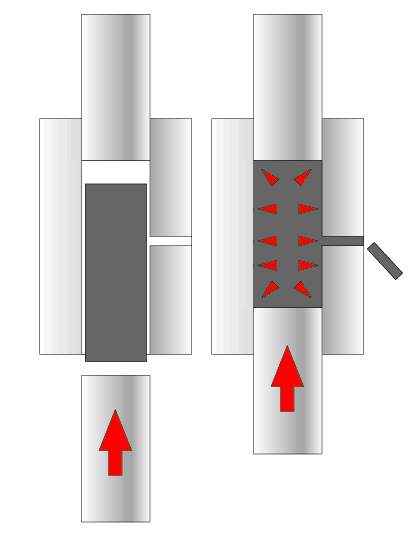
You need a lead core to place in the jacket...
If you are using the reloading type dyes the core is made of pre cast lead or cut lead wire and filed or whittled to the correct weight. If you are using die sets that contain a core swage then this the first step is to cut a lead wire just slightly heavier than needed. Take the cut wire and place it into the core swage, pull down on the press handle and apply pressure to the lead until it fills the die and starts to squeeze out of the bleed hole, once adjusted the core swage will make all of the cores the exact same weight and size. Proper pressure resistant lubrication (I use a lanolin/castor oil based lubrication) is applied to the lead before forming or the core will get stuck. The lubrication must be removed with a solvent like alcohol before the next step.
Second step.
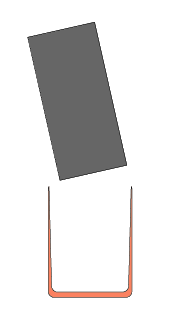
The second step (or first step for reloading press dies) is to place the clean, weighted core into the jacket ready for the core seat die.
Third step.
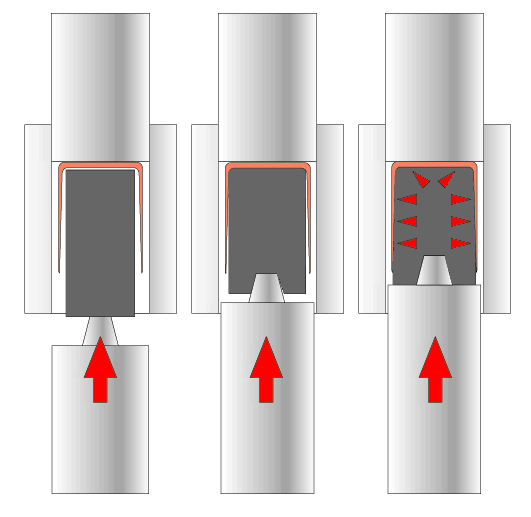
This step is where the core is expanded into the jacket, note that the core when compressed will flow around the punch (and in this case the hollow point is pressed into the lead) until the expansion is stopped by the jacket as it is pressed against the inside of the die.
Note that this punch is made slightly smaller than the inside of the die to fit INTO the jacket to produce a true hollow point with an ogive (curved part of the front) that is covered by the jacket.
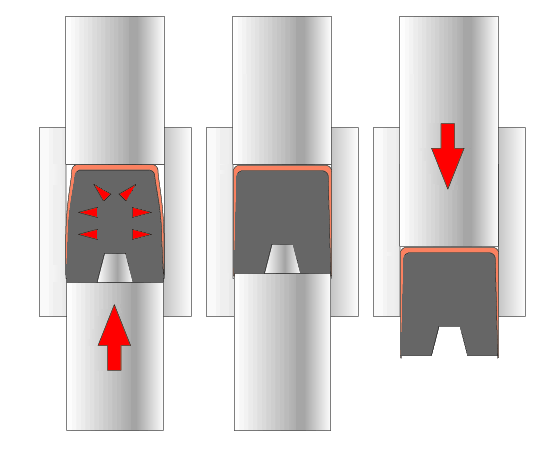
Note that as the punch comes to it's final position the jacket has expanded to the inside of the die with a hard pressed lead core on the inside. As before proper lubrication is necessary or the lead seated into the jacket will lock the jacket into the die, lubrication only on the outside of the jacket.
Once fully seated the jacket and core is ejected from the die.
Fourth step.
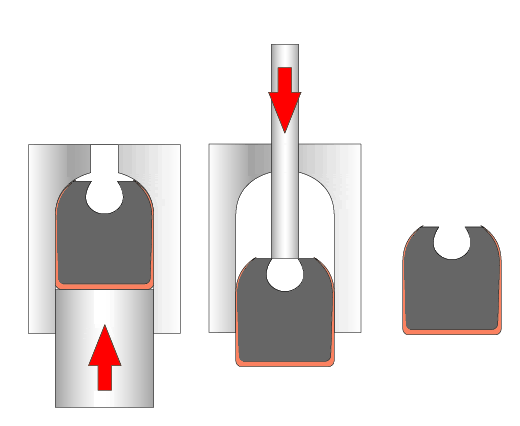
The last step in making this jacketed bullet is to form the point or ogive.
Using the ogive or point forming die, the seated core is placed into the die and will form a point and slightly expand as pressure is applied.
The hollow point is forming under the jacket as the ogive is folded over the open lead.
Once formed the final finished bullet is ejected by a punch.
It takes longer to read that than to do each step...
About the time and force of forming .357 cases and seating a bullet...
For reloading die type swage dies... CH4D
Look under "bullets" from the left hand list...
Go to 101 bullet swage dies...
This is a two step swage die (no core swage) for a jacketed HP...
101410HP 10mm/40 S&W Hollow Point Swaging Die Set - $ 185
Or the soft poont...
101410SP 10mm/40 S&W Soft Point Swaging Die Set - $ 185
The folks at CH4D are great, I have used their "speciality die" custom services before and were great to work with, they make a great product...
The dies they use are the older style Ted Smith type for reloading presses and they can be broken if not uses correctly (in fact all dies can be cracked when using the wrong lead it must be the lead hardness it was designed for harder lead larger holes).
A part of RCE, makes dies for reloading presses...
They also make the special dies for the swage presses (like I use).
I will post more on the CH4D dies and my .355 hollow point set I have.
I can tell you without any reservations that it is much better as a hobby rather than a profession. I also note that reloading in general and casting (I still do some casting, but prefer jacketed bullets) and particularly swaging are rare, not particularly for saving money (yet that seems to be an issue again now) and appeals to a narrow personality type (my wife would call it a disorder). I am about the youngest swaging loader I know of (not 50 for some time yet).
As luck would have it swaging is not that hard to get into if you plan to swage small caliber or pistol bullets (lead or jacketed) as there are “reloading press” swage dies. Although I use a large array of expensive dies I have lots of respect for the CH/4D effort to keep home swaging dies within reason (cost) along with the limited selection of reloading press dies available from Corbin or RCE/Walnut Hill.
Honestly I loved reloading so much that I accidentally got into swaging when I was taking a hunter education course. The older gentleman who was teaching the class was an old buddy of my grandfathers and he had an old swage set from Ted Smith that would do jacketed and 3/4 .357...
I was hooked and then saved up to get my first M style press (I still have it) and started with .224 and then .308 then 9mm, .357 and on.
Swaging like reloading is for the most part not for saving money but rather doing something others cannot produce. A nice thing about making .224 bullets (what the .223/5.56 uses) with old .22 shells is the thin jacket great for varmint shooting, the .22 LR makes a particullarly thin jacket and the FPS that thin jacket can take is almost maxed out with the .223/5.56. For shooting pests and non fur gathering coyote shooting you can't beat a frangable .223 with a thin jacket .22 lr conversion, the bullets are often ugly and great care must be taken not to fold the jacket over (heat-treating helps) - so to make the point again, money savings is killed by the higher labor/time nessassary.
Looking over the Corbin website I was checkig the .22 lr conversion dies (work with a reloading press) to iron out the rim on a .22lr is $130 then you could add the reloading die type set to seat the core and form the point that set is $348.00. That is a 2-die set for .224 cal and makes an 6-S ogive. 6s is a standard ogive, a middle of the road point curve with 3-5 good for heavy hunting bullets with a more rounded nose and 8 plus reserved for target/long range shooting. When I got my first set of conversion dies I jumped full in and got dies and the special press along with the reloading press dies for ironing out the .22 lr rims... the entire set cost less than the above together...





My first MM style press was the "gold" series press (the shortest run ever made) cast from an industrial non spark bronze (and gave it the gold color - now with a nice patina green/brown/gold). If you wanted to cut lead wire or cast cores to weight and seat the core or use "sand shot" to make frangable cores the reloading dies work well as long as you have a good strong press like the Lee Classic Cast Press, RCBS Rock Chucker Supreme (both minumum), or the CH4D Heavy Duty Champion Press. I would not recomend any speciality press or turret press for this operation.

Just to be fair CH4D also makes dies for swaging, but most are made for jacketed pistol bullets, the dies are based on some of the older Herters reloading die thread type of dies. That CH4D press is also a great monster reloading press! For swaging I prefer the Corbin or Walnut hill type press (can double as a super heavy reloading press). The CH/4D dies also require a mallet or a drag-down frame that pushes out the bullet when you return the handle on the press.

The Corbin press with the CH/4D dies and the ejector frame device attached (the threaded posts)
When I ran the business I had a knack for creative bullet design and sold to a specific group of markets - Benchrest, Varmint shooters, and Special demands... All three markets, at least for me represented a demand for frangible bullets (come apart on impact, one of the most popular was a low penetration frangible that had a lower chance of deep penetration in walls and was very good at breaking glass windows without having large heavy parts continue to go past the glass - that was a very special use bullet. Now I make jacketed bullets for my own use, I make just regular lead core target bullets, bonded lead core bullets for hunting, and frangible bullets for shooting coyote (pest removal, as frangible tends to ruin the pelt and I like to use .308 for coyote frangible in .308 would not leave enough pelt to make it worth the work).
I have even produced powder tungsten core bullets for special applications by custom order, but the material is too expensive for general use. I never bothered to make or even atempt much with solid gliding metal or copper bullets because the need for higher level hydraulic equipment was never worth the investment in light of the market availability of higher production run products (like Barnes).
If a a budget is the issue.... I was looking at the RCE site for reloading dies, it seems Richard wanted to make available swage equipment for reloading in a mass-market way to keep the prices down and have items in stock... Both Corbin brothers are notoriously behind in production and rarely have much in stock a crop of new producers are springing up and this is GREAT news. BTSniper Custom Tools and Dies is one such producer.
Prices are lower, and the .22lr dies for the conversion are listed at (Rimfire jacket maker .224 caliber RFJ224-1) $60.00 not a bad price... The two die set for making jacketed bullets (pre cut and weighed core -no core swage (that takes the larger special presses) is listed at (22 .224” Flat base, 6S TOS224-1) $175.00.
So the total with a bottle of lube (this is important - lube and the properuse is one of the keys nessassary) would be about $240.00 for .224 jacketed bullets (not counting lead wire or cast cores) using a good pre existing reloading press ...
Not bad, as far as cost. $240. (Note: prices are now out of date and products may be unavailable)
I though a few would like a simple overview of the swage process with some drawings I made...
The drawings are deliberately exaggerated to explain the process...
The process is based on making cold flow lead swaged jacketed bullets, other materials take a different procedure. The Drawings are also based on the special equipment I have that is designed only for swaging, the reloading press dies work in a similar way but not in the exact same way and also have fewer steps... Swaging is a process of expanding up not squeezing down in diameter, a smaller thinner (but taller) product is expanded under pressure to fill a larger diameter...
Step one.

You need a lead core to place in the jacket...
If you are using the reloading type dyes the core is made of pre cast lead or cut lead wire and filed or whittled to the correct weight. If you are using die sets that contain a core swage then this the first step is to cut a lead wire just slightly heavier than needed. Take the cut wire and place it into the core swage, pull down on the press handle and apply pressure to the lead until it fills the die and starts to squeeze out of the bleed hole, once adjusted the core swage will make all of the cores the exact same weight and size. Proper pressure resistant lubrication (I use a lanolin/castor oil based lubrication) is applied to the lead before forming or the core will get stuck. The lubrication must be removed with a solvent like alcohol before the next step.
Second step.

The second step (or first step for reloading press dies) is to place the clean, weighted core into the jacket ready for the core seat die.
Third step.

This step is where the core is expanded into the jacket, note that the core when compressed will flow around the punch (and in this case the hollow point is pressed into the lead) until the expansion is stopped by the jacket as it is pressed against the inside of the die.
Note that this punch is made slightly smaller than the inside of the die to fit INTO the jacket to produce a true hollow point with an ogive (curved part of the front) that is covered by the jacket.

Note that as the punch comes to it's final position the jacket has expanded to the inside of the die with a hard pressed lead core on the inside. As before proper lubrication is necessary or the lead seated into the jacket will lock the jacket into the die, lubrication only on the outside of the jacket.
Once fully seated the jacket and core is ejected from the die.
Fourth step.

The last step in making this jacketed bullet is to form the point or ogive.
Using the ogive or point forming die, the seated core is placed into the die and will form a point and slightly expand as pressure is applied.
The hollow point is forming under the jacket as the ogive is folded over the open lead.
Once formed the final finished bullet is ejected by a punch.
It takes longer to read that than to do each step...
About the time and force of forming .357 cases and seating a bullet...
For reloading die type swage dies... CH4D
Look under "bullets" from the left hand list...
Go to 101 bullet swage dies...
This is a two step swage die (no core swage) for a jacketed HP...
101410HP 10mm/40 S&W Hollow Point Swaging Die Set - $ 185
Or the soft poont...
101410SP 10mm/40 S&W Soft Point Swaging Die Set - $ 185
The folks at CH4D are great, I have used their "speciality die" custom services before and were great to work with, they make a great product...
The dies they use are the older style Ted Smith type for reloading presses and they can be broken if not uses correctly (in fact all dies can be cracked when using the wrong lead it must be the lead hardness it was designed for harder lead larger holes).
A part of RCE, makes dies for reloading presses...
They also make the special dies for the swage presses (like I use).
I will post more on the CH4D dies and my .355 hollow point set I have.
Personal Critical Review of Firearms - Mauser Bolt Action Rifles
Mauser Turn-bolt Rifles
Personal - I have had several mausers in several calibers. My impressions, first I am not a big fan of 8mm Mauser, it is a hard hitting round and can be accurate, but there are better choices just as there are better choices than 30-06. There is just something "old world" about the full wood stock and metal butt-plate/endcap. In the end, I have to be honest, a turn bolt is just not all that exciting. Ok, a M98k, Swedish M38, or M24/47 Yugoslavian with a bayonet and a full wood stock with a rock crushing butt-plate is one of the starting cornerstones of a collection, what of it? Well, just like all bolt actions they can be loaded down in power and loaded with cast lead or paper patched bullets. even fired with black powder loads. There are cartridge inserts are available for shooting lower power ammunition. Any gunsmith worth a half a spit can do unnatural things with a Mauser including "sporterizing" and an endless array of caliber conversions. My most recent mauser was the M1916 Spanish Mauser in .308, but I have had several examples (far too many) of the M98k one (Israeli conversion in .308), one Swedish M38, and one Yugo. I keep thinking I want one of Mitchell’s "Tanker-Mauser" rifles in .308. I never disassembled any Mauser bolts, just a little sprits of cleaner and hit the barrel with a rod and cleaner, I have also never had a single part break on any Mauser I have ever owned.
Function - If designed for the caliber it currently is barreled for the Mauser is the pinnacle of the bolt action design. All bolt action guns just like the pump, straight pull, and lever action depend on the user moving the action - of all of the manual actions the turn bolt is the most reliable. There is something inherently accurate about the turn bolt and the Mauser for all practical intent is the best of it's type - only tiny incremental improvements have been made after the 98k. I have only had function problems with the conversions, both the Spanish and Israeli conversions to .308 would show failure to feed issues where the round would get turned down into the magazine and fail to feed correctly. Just about anyone above room temperature is capable of understanding and operating a bolt action rifle.
Design flaws - The activation on closing the bolt versions would have better cleaner breaking triggers but are awkward to some shooters like myself. The sights are also typical military inverted v or post and rear notch notch v, the sights can be converted to adjustable with the Mojo sight conversions (nice for any rifle). Complete drop-in triggers or gunsmith modifications can make some US shooters who dislike military triggers happy. Made in a different era they do not have a detachable magazine and were designed to use clips feed into the magazine from the top of the rifle - as with the M1 or FN49 (10 round versions) I find that the clip fed rifle is clumsy and the system outdated. The original examples with metal butt-plates will punish some users, it would not be uncommon to see a new user unfamiliar to heavy recoil even drop a rifle the first time they fire one of the old rock crushers.
Quality - Fit and finish can vary, and condition depended on the users, some are pristine and others (like some of the Israeli conversions) have been so neglected as to be bottom tier trunk guns. Original European manufacture in good condition will be examples of the best of first world craftsmanship.
Caliber/Ammunition - While 7.92x57 is readily available, Mauser rifles were produced or modified for .308, 7x57, 7.65x53, 6.5x55, and a list too long for my desire to reproduce here. One warning be careful of surplus ammunition and the possibility of corrosive ammunition, if left in a Mauser the corrosion in the action and bore can destroy the functioning of the rifle permanently if left too long.
Use - Currently I consider this a great supplemental rifle, a good solid rifle for training and even for a second to lend out when hunting, unlike an "evil assault rifle" even a full stocked military version will only get mild curiosity from the Billy-bob six-packs when hunting with one. Originally designed as a military long arm the design is capable of quick fire and accurate shot placement with rounds far more potent than some small current "assault rifle" calibers.
Current production - There is current production of this old design with some reproductions and some modified, Remington 799, Mitchel, Mauser (new company) and others are available.
Personal - I have had several mausers in several calibers. My impressions, first I am not a big fan of 8mm Mauser, it is a hard hitting round and can be accurate, but there are better choices just as there are better choices than 30-06. There is just something "old world" about the full wood stock and metal butt-plate/endcap. In the end, I have to be honest, a turn bolt is just not all that exciting. Ok, a M98k, Swedish M38, or M24/47 Yugoslavian with a bayonet and a full wood stock with a rock crushing butt-plate is one of the starting cornerstones of a collection, what of it? Well, just like all bolt actions they can be loaded down in power and loaded with cast lead or paper patched bullets. even fired with black powder loads. There are cartridge inserts are available for shooting lower power ammunition. Any gunsmith worth a half a spit can do unnatural things with a Mauser including "sporterizing" and an endless array of caliber conversions. My most recent mauser was the M1916 Spanish Mauser in .308, but I have had several examples (far too many) of the M98k one (Israeli conversion in .308), one Swedish M38, and one Yugo. I keep thinking I want one of Mitchell’s "Tanker-Mauser" rifles in .308. I never disassembled any Mauser bolts, just a little sprits of cleaner and hit the barrel with a rod and cleaner, I have also never had a single part break on any Mauser I have ever owned.
Function - If designed for the caliber it currently is barreled for the Mauser is the pinnacle of the bolt action design. All bolt action guns just like the pump, straight pull, and lever action depend on the user moving the action - of all of the manual actions the turn bolt is the most reliable. There is something inherently accurate about the turn bolt and the Mauser for all practical intent is the best of it's type - only tiny incremental improvements have been made after the 98k. I have only had function problems with the conversions, both the Spanish and Israeli conversions to .308 would show failure to feed issues where the round would get turned down into the magazine and fail to feed correctly. Just about anyone above room temperature is capable of understanding and operating a bolt action rifle.
Design flaws - The activation on closing the bolt versions would have better cleaner breaking triggers but are awkward to some shooters like myself. The sights are also typical military inverted v or post and rear notch notch v, the sights can be converted to adjustable with the Mojo sight conversions (nice for any rifle). Complete drop-in triggers or gunsmith modifications can make some US shooters who dislike military triggers happy. Made in a different era they do not have a detachable magazine and were designed to use clips feed into the magazine from the top of the rifle - as with the M1 or FN49 (10 round versions) I find that the clip fed rifle is clumsy and the system outdated. The original examples with metal butt-plates will punish some users, it would not be uncommon to see a new user unfamiliar to heavy recoil even drop a rifle the first time they fire one of the old rock crushers.
Quality - Fit and finish can vary, and condition depended on the users, some are pristine and others (like some of the Israeli conversions) have been so neglected as to be bottom tier trunk guns. Original European manufacture in good condition will be examples of the best of first world craftsmanship.
Caliber/Ammunition - While 7.92x57 is readily available, Mauser rifles were produced or modified for .308, 7x57, 7.65x53, 6.5x55, and a list too long for my desire to reproduce here. One warning be careful of surplus ammunition and the possibility of corrosive ammunition, if left in a Mauser the corrosion in the action and bore can destroy the functioning of the rifle permanently if left too long.
Use - Currently I consider this a great supplemental rifle, a good solid rifle for training and even for a second to lend out when hunting, unlike an "evil assault rifle" even a full stocked military version will only get mild curiosity from the Billy-bob six-packs when hunting with one. Originally designed as a military long arm the design is capable of quick fire and accurate shot placement with rounds far more potent than some small current "assault rifle" calibers.
Current production - There is current production of this old design with some reproductions and some modified, Remington 799, Mitchel, Mauser (new company) and others are available.
Personal Critical Review of Firearms - The Mosin-Nagant Rifle
Mosin-Nagant Turn-bolt Rifles
Personal - The real question is - why don't you have one of the Soviet Hammers?...
The Mosin-Nagant is most likely the least expensive, reliable, powerful, and sometimes accurate bolt action rifle model available. Crude, often not cared for well, but about as simple as any turn bolt can get - you could make this rifle in a small primitive machine shop with barely competent labor - oh, yea, that is what it was designed for.... The ultimate throw down buried in a tube last ditch peasant with pitchfork rifle. I actually like this rifle, it has the same type of strange romanticism as a lever action or a single action pistol, I find myself drawn to this turn bold over the Lee-Enfield. My personal Mosin-Nagant choice is the Model 1944 Carbine and I would typically want to remove the bayonet and modify or make a new stock.
The original Girls with Guns
Function - Just about anyone above room temperature, except a neocon lickspittle or neo-liberal progressive is capable of understanding and operating this bolt action rifle. The stiff, awkward bolt sadly will disrupt your sight picture and takes an exaggerated movement to operate, but it works well and is solid and dependable.
Design flaws - I find that all clip fed rifles clumsy and the clip feeding systems outdated, the Mosin-Nagant clips are a fold around style that are odd and awkward to use. The original butt-plates combined with the recoil is punishing to many users. The triggers are often loose and gritty with a high effort needed to pull to fire. The rifle uses a cartridge that is outdated and often supplies are Berdan primed and corrosive making reloading more difficult and cleaning a ritual necessity. Headspace on the rim, simple production but problematic with reloading.
Quality - Fit and finish are often crude, the best examples will be surplus from Finland. Condition often depends on the manufacture and secondly the storage and use from the country of origin before import. Some examples will be reasonable while others are so abused that they would most likely be best for arming friendly troglodytes.
Caliber/Ammunition - Readily available surplus ammunition is possibility or likely corrosive, corrosion in the action and bore can destroy the functioning of the rifle but with this simple design this neglect would have to be advanced. Modern ammunition and Boxer primed brass cases are available, this ammunition even lends itself to be loaded with black powder and of course will function quite well with simple cast lead bullets. While this is a primitive rimmed round it is very powerful and capable of bringing down even large game like elk and bear with ease.
Use - I consider this a supplemental rifle, a solid rifle for training and arming reformed neocons retarded reformed liberals and other useless troglodytes unfamiliar with the necessary skills. This could be a good inexpensive second to lend out when hunting and even modern stocks are available (almost the cost of the original rifle). Like all old turn bolts this is not an "evil assault rifle" leaving this rifle in original full stocked military furniture will only get mild curiosity from the typical troglodyte Billy-bob six-packs when hunting with one. Originally designed as a military long arm to arm simple peasants in mass with rounds far more potent than some small current "assault rifle" calibers.
Current production - I am not aware of any current production (outside of modifications) of this very old design but surplus examples can be measured in tons! the surplus is drying up somewhat, the relations with Russia and the US are starting to sour. There are many models from several countries and many modifications.
Personal - The real question is - why don't you have one of the Soviet Hammers?...
The Mosin-Nagant is most likely the least expensive, reliable, powerful, and sometimes accurate bolt action rifle model available. Crude, often not cared for well, but about as simple as any turn bolt can get - you could make this rifle in a small primitive machine shop with barely competent labor - oh, yea, that is what it was designed for.... The ultimate throw down buried in a tube last ditch peasant with pitchfork rifle. I actually like this rifle, it has the same type of strange romanticism as a lever action or a single action pistol, I find myself drawn to this turn bold over the Lee-Enfield. My personal Mosin-Nagant choice is the Model 1944 Carbine and I would typically want to remove the bayonet and modify or make a new stock.
The original Girls with Guns
Function - Just about anyone above room temperature, except a neocon lickspittle or neo-liberal progressive is capable of understanding and operating this bolt action rifle. The stiff, awkward bolt sadly will disrupt your sight picture and takes an exaggerated movement to operate, but it works well and is solid and dependable.
Design flaws - I find that all clip fed rifles clumsy and the clip feeding systems outdated, the Mosin-Nagant clips are a fold around style that are odd and awkward to use. The original butt-plates combined with the recoil is punishing to many users. The triggers are often loose and gritty with a high effort needed to pull to fire. The rifle uses a cartridge that is outdated and often supplies are Berdan primed and corrosive making reloading more difficult and cleaning a ritual necessity. Headspace on the rim, simple production but problematic with reloading.
Quality - Fit and finish are often crude, the best examples will be surplus from Finland. Condition often depends on the manufacture and secondly the storage and use from the country of origin before import. Some examples will be reasonable while others are so abused that they would most likely be best for arming friendly troglodytes.
Caliber/Ammunition - Readily available surplus ammunition is possibility or likely corrosive, corrosion in the action and bore can destroy the functioning of the rifle but with this simple design this neglect would have to be advanced. Modern ammunition and Boxer primed brass cases are available, this ammunition even lends itself to be loaded with black powder and of course will function quite well with simple cast lead bullets. While this is a primitive rimmed round it is very powerful and capable of bringing down even large game like elk and bear with ease.
Use - I consider this a supplemental rifle, a solid rifle for training and arming reformed neocons retarded reformed liberals and other useless troglodytes unfamiliar with the necessary skills. This could be a good inexpensive second to lend out when hunting and even modern stocks are available (almost the cost of the original rifle). Like all old turn bolts this is not an "evil assault rifle" leaving this rifle in original full stocked military furniture will only get mild curiosity from the typical troglodyte Billy-bob six-packs when hunting with one. Originally designed as a military long arm to arm simple peasants in mass with rounds far more potent than some small current "assault rifle" calibers.
Current production - I am not aware of any current production (outside of modifications) of this very old design but surplus examples can be measured in tons! the surplus is drying up somewhat, the relations with Russia and the US are starting to sour. There are many models from several countries and many modifications.
Monday, April 4, 2011
Personal Critical Review of Firearms - Bolt action .22 LR rifle

Personal - Almost my secret sin, if given a choice I would love to blow a thousand rounds at the range with a bolt action .22... It takes almost all day to cook off that much ammo, but it sure is fun.. and great for kids. Millions of squirrels have been taken for the pot with bolt .22 rifles, I tried to take as many as I could with my turn bolt as a young kid... If you do not have a .22 rifle you should get one, in the long run most likely to most productive way to get small game for the table, from birds to rabbit if it sits still for a split second it is pot meat... A good quality manufactured example should last a lifetime.
Function - Excellent reliable function if reasonably made, Mongo turn bolt, Mongo pull trigger with bugger hook, fire stick go BOOM. Ok, so not every .22 is that easy, well, actually it is, almost, let's start with the bad one first -
Romanian M-69 .22LR Training Rifle - The worst of the lot, lots of flaws. For starters, it is ugly and poorly finished, I had two because they were so inexpensive, and they shared problems... Trigger was crap, and the spring for the firing pin must have been of low strength because about every ten rounds you would have to cock it a second time to fire (both rifles were like this). Reasonable to good accuracy when you don't mangle a bullet from the magazine to the barrel, this happened almost every round. Sold them don't miss them.
Russian Tula TOZ-78, Winchester Wildcat - my current go to general use .22, when I get a chance to hunt small game or just shoot short range off hand this is the rifle I pull out of the safe first. The trigger is adjustable and is crisp and smooth almost as good as the Remington (listed below). This is now imported as the Winchester Wildcat bolt action rifle. I purchased this rifle in its original Russian format - the Wildcat is a modified version of this rifle with non-adjustable trigger typical cheep stamped sights (worse than the russian sights) and a bit nicer wood stock.
Norinco JW15 - I miss this rifle, I sold it and would love to find a second one (if I could find a good price) accuracy on par with the Tula, but the trigger was not as nice, and the bolt not as smooth in operation. Safety was awkward and rough in operation but better than the Romanian rifle.
Marlin Model 980S - I gave this rifle to a member of the family, it is an excellent .22 with excellent accuracy. Stainless model was almost maintenance free, the trigger was acceptable, but could be much better.
Remington 513 Matchmaster - A CMP rifle that is the best NON SPECIALIZED .22 I have ever fired, accuracy is superior with premium target .22 lr it will shoot tighter than 1/2 MOA.
Design flaws - Strangely almost all .22 bolt guns share one particular problem, feeding the small rounds from a magazine into the bore often results in the bullet scraping the top of the entry port and sometimes shaving some lead off or mangling the bullet, however Marlin figured this out I do not know how but the Marlin clip fed bolt actions do not do this, I think it is the magazine design.
Romanian M-69 - The feed ramp and magazine are poorly designed and lots of lead would get shaved off the bullet going into the barrel or the bullet would get bent out of the casing (if you were not watching) the safety was awkward to the point of unusable and the magazine was of poor design and function. Typical eastern sights of very poor quality a hooded front post and square slot rear "flip up" range selection. Magazine catch lever was primitive bent spring metal.
Russian Tula TOZ-78 - A relatively smooth working action. The stock is a bright wood, I cover it with a slip on camo cover when needed. Light and accurate but shares a similar feed issue with the Romanian .22 you have to be careful when pushing the cartridge into the chamber so as not to shave off lead. A little work on the feed ramp and port are necessary, the plastic magazine works well but the rifle only had one magazine and I cannot find a spare. I would like better rear sights, but they work well for typical russian Post and square notch with turning rear to adjust for elevation by 25 meter increments. I don't like the placement of the safety at the bottom front side of the magazine well, but you can get to it with the left hand while holding it. The magazine release button is a dedicated part in front of the magazine/trigger guard projection piece and is awkward due to placement inside a slotted front section.
Norinco JW15 - Stiff action, simple construction, a typical Chinese copy of a european rifle (BRNOish) sights were crappy, but the rifle worked nicely with an inexpensive scope, similar to the Marlin. Magazine catch and release lever is a primitive bent spring assembly that takes a dedicated finger or thumb pressure.
Marlin Model 980S - Stiff action, but solid and simple, with a simple bent sheet metal extractor and guide. This rifle has a cheesy synthetic stock, but it is light weight and functional. Similar to the norinco the magazine catch is primitive and takes a dedicated finger or thumb to release.
Remington 513 Matchmaster - Smooth bolt action with excellent machining, excellent trigger, mediocre plastic magazine, heavy - in fact, far too heavy for reasonable carry for small game hunting, this is a full featured target rifle. Magazine catch is also primitive for a rifle this well manufactured.
Only the Remington had a full length stock comfortable for full sized male shooters, the Tula and Marlin were close and function in that regard well enough.
Quality - Varying quality from basement construction to top notch... They can go from reasonable accuracy to superior and from poor fit and finish to first world commercial quality. Buy what you can afford, past the bargain basement versions unless restricted by budget. Any of the listed rifles are good utilitarian choices that would serve well as field rifles (Except the heavy target Remington).
Caliber/Ammunition - .22 LR is very inexpensive ammunition with almost no recoil, even the bulk box .22 LR can be reasonably accurate. If you choose target grade ammunition they can be shocking in accuracy, high velocity rounds can be effective in hunting even larger game with proper placement. In backwoods areas many whitetail deer were dropped with head shots using the .22 LR (that was actually legal at one time).
Use - Easy to strip and clean (not that you need to at all with non corrosive .22 LR) EVERY collection should have at least one.
Current production - The Tula (as the Wildcat), and Marlin rifles are under current production.
I consider the .22 rifle a necessary utilitarian tool, too many brands to name are in current production, and they are popular, easy to find, and inexpensive to buy and feed. They make adult and child models and make a great trainer and hunting tool. Many excellent models are available that I have not listed here almost any name brand in the US will have at least one offering of .22LR in a bolt action.
The SAFN 49 rifle in 7.62x51

I looked for about 3 years for a good .30-06 or the .308 conversion, both came up at the same time and I opted for the .308 with six magazines and a cracked stock for $950 over a .30-06 Luxembourg for $1300, the .30-06 was a far second choice, but would have gotten one in that caliber if I had found a good one for 700-1000.
A batch of about 1000 of the .308 versions came in in the late 90's and a second batch of 1000 in 2003, I missed both, the second batch was selling for about $650 each with a bayonet...
The FN49 is the last of the machined, wooden stocked, MBR's and is the direct father of the FNFAL, the shared features are quickly obvious.
The FN49 came in more calibers than any other military rifle and was sold directly from FN on a contract basis to each of the individual countries, and even a few individuals, police forces and companies while in production.
The wiki has some of the information wrong, FN did not modify the bulk of the Argentine rifles, in fact FN only converted ONE as a test on order from the Argentine Navy... The full contract to conversion was produced by Metalurgica Centro/Halcon in Argentina. They did a nice job and at first I thought the stamped numbers indicated an FN job, no, MCH copied the stampings and matched the rifles to the conversion parts. Every rifle in the Argentine contract except a few samples purchased by individuals and museums was converted - over five thousand.
The contracts were Argentine, Belgian, Belgian Congo, Brazilian, Colombian, Egyptian, Indonesian, Luxembourg, Luxembourg Police, and Venezuelan, there were Sniper versions and many prototypes, presentation models and special orders for small orders even some individuals...
K-mart sold quite a few for less than 100 bucks (69.99 I think) in the 30-06 versions...
Except for the 2000 plus .308 in Argentina and the bulk of the Indonesian contract almost every other contract rifle was destroyed in war/conflicts, or sold to private individuals, I would risk a guess that over 80% are here in the states in private collections.
Dieudonne Saive patented what would become this rifle in 1936, worked on prototypes then due to the war it was not to hit the production floor until 1948... He would use many of the concepts and functioning of this patent in the FN FAL...
While the Fn49 did not see as much combat as other rifles, it was involved in many local conflicts in contract countries, and can be seen in many third world hot spots. The Argentine version was involved in the Coup attempt, and heavily involved in the civil war/September rebellion. All Belgian troops in Korea (Once assigned to the US 3rd Infantry support) were issued the FN49 in .30-06. The Belgians also used the FN49 in the first stages of the Congo Civil War. The Belgians have a habit of keeping rifles in small individual armories and many FN49 rifles ended up in "hot spots" in Africa because of the Congo armories. In the Congo there was a chance where the FN49 rifles from FOUR countries and several calibers could have come into the same conflict...
The conversion of the FN49 in Argentina was AFTER the adoption of the FN FAL, they were regulated from the Army to the Navy and placed on ships... Later to inact caliber compatibility they were converted to .308. They use a modified magazine that is unique to the conversion and is expensive, the top was cut and formed to use the standard metric FN FAL stripper clip charger/loader.
The .308 barrel is 23 inches and has a twist of 1 in 12 inches and the 30-06 is 1 in 10... the .308 versions have chrome lined barrels and chambers (is nice yes?)... the gas piston tube and gas piston are not chromed (boo).
I is an exceptionally accurate rifle that is as reliable as the FN FAL (with some modifications). Will it stay in the collection? I do not know.
Personal Critical Review of Firearms - Kel Tec SU 16 CA
Personal - There are several versions of this rifle, I purchased the rifle for my youngest boy, I had a previous version, but chose the CA incarnation because of the threaded heaver barrel, shorter length, and improved front sight (back aperture sight is crap). I like it... I am not a fan of .223 but the rifle is handy, capable of reasonable accuracy and is based more on the AK than the AR platforms. Very light weight, and it has a neat folding stock making it very small an easy to pack. I found I liked the folding stock that folds out into a traditional stock, it looks a bit queer but it feels good in the hand for shooting, very comfortable.
Function - Excellent reliable function, an earlier version also was excellent in reliability, this version has been 100% with every magazine I have tried, it likes both 20 and 30 round Thermold (LE marked) 20 and 30 round Tapco, and two old 30 round Adventureline magazines someone gave me years ago.
Design flaws - The front folding hand-guard will fold out into a "bipod" if you want to call that spindly insect like abomination a "bipod" I used it for a few magazines worth and never bothered again my first thought was "tits on a boar-hog" and that did not change after I gave it a chance, have not bothered to unfold it again except to clean under it.
Light weight also translates to lightly constructed, you would not want to hit someone with it like you could a Mosin-Nagant, but the construction is not THAT bad, that is as bad as some input I have seen from who think that every gun has to help fight you out of some muddy foxhole.
There is a trick to getting the bolt in and out, follow the directions it is not "user intuitive.” Take great care not to launch parts into low earth orbit (or into your body) in disassembly, spring loaded parts could be easy to loose. Rear sight aperture is crappy cheap and the safety is a funky shotgun-style cross bolt. The full stock of the CA model will not allow the rifle to fire folded, that could be a problem if you needed a quick "get to” while folded, but the weirdo version of the pistol grip folder is just too funky, when I ordered my "california" version the dealer also ordered one of the funky pistol grip versions for the shop - Blech! even he said he hated that version and liked the CA better.
Quality - Molded polymers - and you can tell there are some "corner cutting" parts here and there - you can tell this was intended as a light duty carbine. I would choose the SU16CA rifle over the Mini 14 (problems and all) any day...
Caliber/Ammunition - .223 small, inexpensive (well, as inexpensive as surplus or new center-fire is going to get nowadays), light recoil, accurate, not all that exciting but it is a carbine, what did you expect?

Use - Accuracy is reasonable, better grouping when hot (or cold) than any Mini-14 I have ever seen but NOT on par with the AR15, about halfway from Mini-14 to AR, and less expensive than both. Uses standard AR15 magazines and has two little 10 rounders that press fit into the stock and can stay (well they are supposed to stay in, just don't hit it too hard when open) there when folded - as the Russians would say "is very nice, yes?” - of course, and inexpensive also.
Current production - Waiting at the Kel tec factory fresh off the molding machine, this entire series of rifle is one of their most popular products, and is not always in great supply.
I consider this rifle a secondary choice carbine or a nice light weight, light duty carbine for small users. The SU16 series is in a mid range price level and is less expensive than either the AR or Mini 14. Currently in production, using popular easy to find magazines, and small limited parts interchangeability with the AR make this an attractive choice. I use this rifle myself for hunting where a light carbine is required, but was intended for the smallest child, he loves it. (Update: I have acquired a second SU16CA and both are now regulated to the two women in the family. We use them for small game and varmint hunting quite regularly and both have received a solid diet of reloaded brass and steel cased ammo with no function problems.)
Reloading imported (boxer primed) steel .223 cases
I have seen posted both pro and con of reloading steel cases, but not enough info to make a good judgment, so I started picking up the Wolf .223 fired cases.
I have also (far in the past) reloaded Berdan primed cases, I fount the experience "less than satisfying" for the time expended, Berdan primed cases CAN be reloaded but it requires more time.
Steel cases are harder than brass and some rifles could have parts damaged by the harder steel cases (a possibility, but this author has not had that experience).
I prefer to find my own answers based on experience or facts based on documentation. Far too much has been posted containing too much conjecture about how the steel is too hard for the dies but NO FACTUAL DOCUMENTATION. What we do know is hard on dies is abrasives on the cases or abrasive contamination in the dies (dirt) the dies are considerably harder steel than the Wolf casings.
So I decided to experiment myself, I was willing to risk the sizing die just to document what happens for my own answers and to test the results.
I know that most dies are hardened far above and beyond what any steel case and it’s material could damage, aluminum cases would be adding abrasives to the mix, but steel with lubrication should be well within the working range of the dies. Of course I was making a guess that the steel cases are not as hard as one would think (or as much as has been posted on the internet), I see no damage so far with the current dies I am using, I have been keeping an eye on measurements of the dies to see as I progress in this experiment. (Update, no change whatsoever)
So far I have picked up Wolf .223 that is boxer primed every time I go to the range - I live in a desert area, so rust is not that big of a problem, some are pitted more than others and the worst examples are culled.
I tumbled them using simple play sand to nock off the paint/polymer and to clean out any rust inside or outside, and remove any of the worst of the rust. I then vibrate them in walnut abrasive with paper towel strips and old fabric softener sheets and three teaspoons of mineral spirits, just to make sure the sand does not get in the dies. (Update, I have changed to a water wash and quick dry prior to sizing, the rust has not become a problem, but it will develop.)
I then size with a mix of lanolin and castor oil (swage lube-anti rust), trim, and vibrate them again as above... They come out nice and silver shiny, I shoot them quickly so I don't bother waxing or painting the cases, a thin wipe with lube wax or even swage lube would prevent rust, but I don't bother. (Update, I have switched to vegetable cooking oil for sizing as it is easier to remove.)
I was going to anneal the cases, but I decided not to, so that I could simulate less than optimum conditions (normal) along with a warning I recieved. I was warned that annealing Steel would be different than brass. It involves heating the steel to a known temperature and then keeping it at that temp for a set time. You then have to cool the steel in a controlled matter. If a user attempted to anneal steel like brass the result will be hardening of the steel and Increased brittleness.
Here is what has happened so far...
I am shooting them out of four rifles, a T C encore, a bolt action, an HK 630, and an AR 180 franken clone (more on that later). (Update, currently the two KelTec SU16 rifles are digesting the steel hand-loaded ammunition.)
The HK rifles, with three shots in you can tell the fouling gases were passing the flutes. HK and steel, possibly not the best combination but that is not a big secret. The HK had a few slam fire problems with the .223 but that is also true of military 5.56 cases of brass. (Update, a switch in primers eliminated this problem and now unlike the Military brass cases, the steel cases work fine without any problems.)
TC Encore - I honestly could not tell the difference from the Wolf and the military brass I often use, with the same loads it all shot in a similar way, I even did a blind mix and the groups did not show any significant change, there is more fouling around the case mouth. Sooty and black it indicates that the case is shrinking at the mouth when pressures drop, the bypass does not show "jets" of gas bypass.
Bolt rifle, similar to the Encore, but tends to group to the left about .25 inch at 100 yards compared to the brass cases (the drift could easily have be environmental not the ammunition), no particular change in group size. (Update, change was environmental as this drift cannot be repeated, in other words it has not happened again.)
AR 180 clone (the V18) fouling to the case neck, no jets, black and sooty, but it does this with brass cases, I note a light increase with the steel cases
While all of the rifles showed similar issues, the AR180 clone is the hardest on cases (any case brass or steel), because I knew it was abusing the cases, I keep the best records on what was happening.
First cycle of reloading, any cases that had pitting from rust at the case mouth split from edge to edge on the mouth at the pitted areas (of the pitted cases) one in five split- one reloading.
Second reloading, more splits on pitted cases at about one out of three, the fresh cases that did not have any rust did not show signs of distress.
Third reloading, more splits on pitted cases now at about half of the pitted cases, one pitted case ruptured at the mid point. Fresh cases start to show splits at the mouth one out of about dozen.
Fourth reloading, most of any pitted cases are now gone, and the fresh cases start to split at the mouth at about one in each ten. I have not loaded further at this point...
I found the rejects at just above what I get from military brass cases, for free "pick ups" the fresh fired cases are not bad for an abusive autoloader, the reloads are much more accurate than the original loadings of wolf and I can shoot Varget (my favored powder) with bullets of my choice.
I have not broken any parts on the autoloader (extractor or ejector) but the work hardening of the cases is evident with the mouth splits.
I think that while I am using a small sample it clearly points out that the steel cases DO NOT last as long and have peculiar properties when compared to brass cases and reloading.
I certainly would not argue that for the purposes of reloading, clearly the brass casings are superior, even if it were a matter or a few statistical percentage points that would prove the issue, in this case it is clearly far more than just a few percentage points of improvement.
While a good quality rifle can shoot inexpensive ammunition at least to mediocre levels a bad rifle will shoot even premium ammunition at lower than mediocre levels. Accuracy does not seem to be significantly influenced by the use of a steel case.
While not as well documented as I would like, the experiment showed that while not as easy to work or as long lasting, the possible accuracy is similar if not on par with brass casings for general use loading. With all other items the same, quality bullets, primers, and powders and the same loads, steel cases showed no change in accuracy.
This makes a point that the case, when construction sizes are within a specific tolerance range, is not the arbiter of accuracy as much as the charge of powder, bullet quality and suitability of the bullet size and powder charge to the particular rifle.
I will continue to progress with this experiment if only to answer the question in a way that is satisfying. In some ways I feel some satisfaction in even reusing the cases even one time rather than regulation to the garbage or scrap dealer, in the same way I fee satisfaction in local recycling programs.
Why are steel cases on the ground at the range and brass is not? Clearly two valid reasons, value of the scrap and ease of use while reloading.
Berdan priming is an issue because most steel cases are produced with berdan priming, and boxer priming is much easier to size and remove the primer in one simple operation.
There is the possibility of corrosive components used in steel cased surplus ammunition.
Disinterest in the cases due to simply to reputation.
I chose to reload the .223 Wolf because it was plentiful, made with non-corrosive components, and produced with a standard style Boxer primer. I guess that makes me more "green" as a hand-loader.
The reloading of boxer primed steel cases took far less time and effort to reload than brass berdan cases would take. In that regard I was also noting that the reloading of the steel cases was showing no more "wear and tear" on the dies or the rifle used to fire them.
Certainly there is no current shortage of brass casings, and outside of price they are a better choice. So outside of a desire to stop "seeing something go to trash" and the willingness to risk as set of inexpensive dies for an experiment, there was no reason outside of simply testing theory with application. I note no "wear and tear" on the dies nor any undue added difficulty in effort to form cases, prime, or trim in comparison to military brass. I consider this a successful experiment, and specific questions were directly answered with actual testing.
If I feel to lazy to pick up a batch of reloaded steel cases for additional loadings, I can fee justified in allowing them to rust in positions knowing I used them once and that the reloaded versions fired with more accuracy and were of more consistent nature than the original Russian factory loading.
I started reloading from the start because it was conservative in nature, and handloading will provide better control than factory offerings. The reloading hobby/habit is then justified yet again. Reloading is certainly not primarily to save money, because when counting labor, it never was less expensive. Most likely never will be, outside of obscure and rare calibers or loadings.
I wanted to check, the negative comments on loading steel cases were all "I won't even try it" I was willing to risk my dies, I'm just not willing to tell someone "you can't do it" or "that would be bad" when there were no reliable sources for a factual response.
It is clear from my current experiment now close to 4000 rounds of steel cased .223 wolf full length sized and ABSOLUTELY NO CHANGE IN THE THE DIES OR ANY WEAR that I can detect with my micrometer or calipers...
I do use a very good lube I make myself with castor oil and lanolin (a swage lube) to make sure none of the cases get stuck, and I make sure the cases are VERY clean and no rough pitting before I size (but I do that with brass cases)...
This testing holds that steel cases have little to no effect on the dies or their performance in comparison to brass cases.
I'm not saying that they could or could not be harder on an extractor, or ejector on a rifle as that is outside of the testing I was conducting. Testing with real world supplies and actual use of product, I am not making a guess, I am actually using the product and keeping an eye on the results, I may not even use all of the cases, but I wanted to see and was willing to risk the dies. The testing showed, at least with Lee dies steel cases can be processed and there is no additional wear...
With clean cases, well lubricated, and use of reasonable quality dies it not only works but is of little difference or consequence ON THE DIES and the physical effort required is only slightly elevated from the brass cases, far less effort than .308 brass full length sizing.
I think the fear of this was only speculation based on comparison to the steel cases performance with extractors on auto-loading rifles.I will gladly note any damage if only for a warning to my fellow handloaders, but as it stands now I do not note any additional die wear or damage, while the steel cases are NOT better than brass for our use as hand-loaders they are clearly also NOT quite as bad as I have seen them made out to be either.
Subscribe to:
Posts (Atom)
